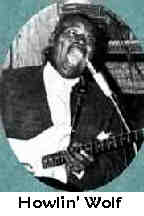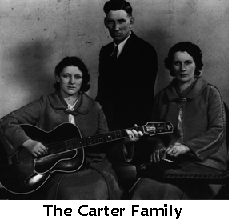
Making music is a
circumstance under which people of both races could mix without
raising very many eyebrows. Even those intolerant of integration
could overlook this behavior by musicians. Musicians, being more
concerned with the music than with race, certainly did not have
any problem incorporating and relying upon the talents of black
musicians. Tearing down racial barriers in the musical setting
made progress toward tearing them down in other settings. This
section looks at examples of integrated bands and black musicians
working with white producers, distributors, and managers and their
positive effect on race relations.
David Harrison, author
of Blues: A Photographic Documentary, says that it has
only been lately that historians have appreciated the high degree
to which music was integrated in the rural south, even in areas
where the clutch of the Ku Klux Klan was mighty and racial boundaries
were clearly defined. Rumor has it that the local chapter of the
Ku Klux Klan managed Jaybird Coleman, an early blues harmonica
player. Due to this integration, identifying the origins of songs
and styles becomes increasingly difficult as one traces the music's
development. There are traces of flamenco in some blues, such
as Buddy Boy Hawkins, a uniquely talented country blues guitarist
and vocalist, which historians believe was brought home by World
War I soldiers. Also, the slide guitar, which quickly became a
substantial aspect of blues music, was most likely brought over
from Hawaii. Several white artists such as Monroe Moe Jackson
and Harmonica Frank were long incorrectly thought to be black,
while the jury is still out on Julius King and Rhythm Willie1.
Some examples Harrison
gives of such integration are Andrew and Jim Baxter, two black
musicians who played with the white group called The Georgia Yellowhammers;
Oscar Woods and Ed Shaffer, two black slide guitarists who played
with white country music singer Jimmie Davis; Jimmie Rodgers,
who was famous for his blues yodeling, recorded with both Louis
Armstrong and Clifford Gibson. Rodgers even rearranged a song
by the Clifford Hayes Jug Band and recorded it with the band.
"Jimmie Rodgers yodels permeate the blues of the thirties:
sounds of black America in turn pervades much of the white country
music, particularly that of Rodgers himself2."
Rumor has it that it was  Jimmie
Rodgers who gave Chester Burnette his nickname, Howlin' Wolf,
upon hearing that unique "howl" one night when the two
met on the road3. Amèdè Ardoin, a black
Cajun accordionist, and his once neighboring sharecropper and
white accompanist, Dennis McGee were once popular duo. Two wandering
black musicians taught Frank Hutchinson, a white songster from
West Virginia, how to play slide guitar in a genuinely black style,
which he demonstrated well on his 32 records. Curley Weaver, a
country blues artist from Georgia, and Buddy Moss greatly impacted
the music of Cliff Carlisle, a white country music genius4.
Listen to Chicago Bob commenting
on the role of music in integration. Jimmie
Rodgers who gave Chester Burnette his nickname, Howlin' Wolf,
upon hearing that unique "howl" one night when the two
met on the road3. Amèdè Ardoin, a black
Cajun accordionist, and his once neighboring sharecropper and
white accompanist, Dennis McGee were once popular duo. Two wandering
black musicians taught Frank Hutchinson, a white songster from
West Virginia, how to play slide guitar in a genuinely black style,
which he demonstrated well on his 32 records. Curley Weaver, a
country blues artist from Georgia, and Buddy Moss greatly impacted
the music of Cliff Carlisle, a white country music genius4.
Listen to Chicago Bob commenting
on the role of music in integration.
More evidence of integration
is revealed by the Carter Family, a famous white country music
group who declared that they learned many songs from Leslie  Riddle,
a not so famous black songster and guitarist from North Carolina.
Riddle did not make his first recording until the blues resurgence
of the 1960s5, but historians believe it may have been
Riddle who taught Maybelle, the matriarch of the Carter Family,
the steel guitar techniques she uses on the very popular "Little
Pal of Mine6." Riddle,
a not so famous black songster and guitarist from North Carolina.
Riddle did not make his first recording until the blues resurgence
of the 1960s5, but historians believe it may have been
Riddle who taught Maybelle, the matriarch of the Carter Family,
the steel guitar techniques she uses on the very popular "Little
Pal of Mine6."
Freddie Vanderford
is a blues musician from Union, SC who began playing blues as
a young boy. He was introduced to the music of Peg Leg Sam Anderson
in 1969 as a 10th grade student. With a little luck and his own
tenacity, Freddie tracked Peg down one evening and asked him to
teach him about the blues. At first, Peg was resistent because
he was not convinced this white boy had what it took to be a blues
musician. Freddie proved his committment to the blues and to Peg
by spending hours with Peg taking him to run errands, gathering
his firewood, and toting water from the neighbor's house a football
field away. Eventually, the friendship and trust between the two
grew firm and Peg shared his music with Freddie. Although Freddie's
friends and family were not thrilled with him for spending most
of his time wrapped up in blues music and hanging out with its
black practioners, Freddie nor Peg seemed to notice the color
differences between the two of them. Click here to listen to Freddie describing
their relationship.
Dan Penn, a white
singer/songwriter from Alabama, once said "Our rhythm 'n'
blues was about blacks and white people intermingled." Joe
Tex remarks, "I used the same formula every time - half soul
musicians, half country musicians." David Porter spoke of
his collaborations with Isaac Hayes "It's a mixture of people
giving their ideas…and molding them into an individuality.
Hayes and I even study country-and-western tunes because we have
discovered some of the greatest lyrics in the world come from
there7." Listen to Kip Anderson, a blues
artist from Starr, SC, talk about the racial differences in the
world of music.
Al Bell, a black songwriter
for Stax who later became president, thought that the label's
integration was an allegory for societal integration. He described
the company as "a combine which has been integrated, basically
since its inception…I'm very proud of this and think that
because of this we should be considered a model for other businesses
- not just the record business, but any businesses that doubt
that black and white people can work together8."
Harrison states:
The examples are
endless, but the conclusion is the same - music was music, and
if a white musician liked a black sound, or vice versa, then
there was no social disgrace in adapting it…So blues was
always a multi-racial music. More importantly, surely, is the
fact that it was the one musical common denominator for the poor,
the exploited, the wage slaves of both races who often shared
the same deprivations in the mines, the factories, and the fields.
It was a music that grew from within those mixed communities9...
1. Harrison,
15-19
2. Harrison, 18
3. Bane, 85
4. Harrison, 15-18
5. Davis, 41
6. Harrison, 18
7. Ward, 222
8. Ward, 225
9. Harrison, 18
 Back to top Back to top
|
